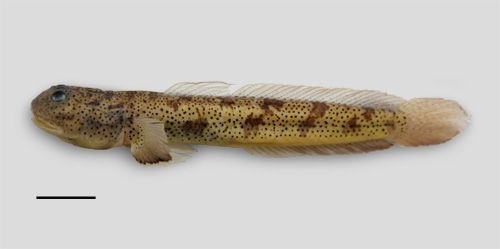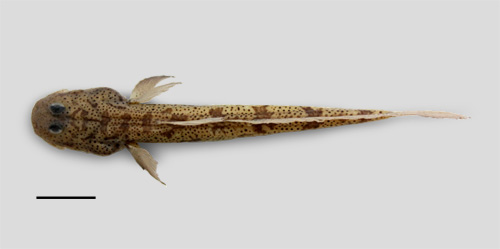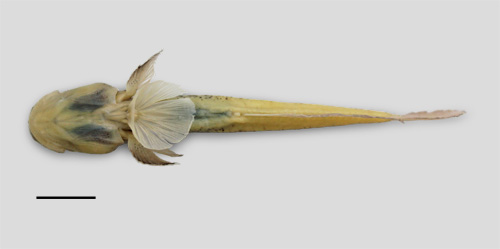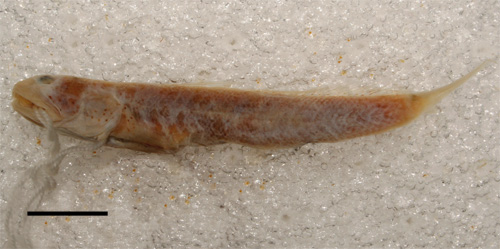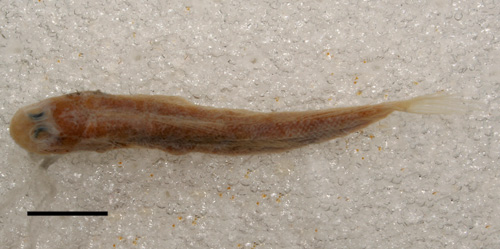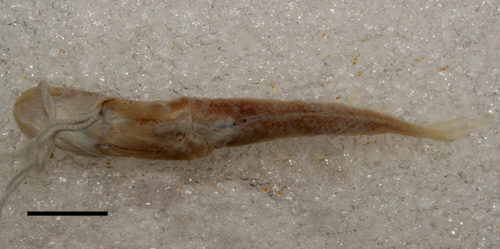Common names:
|
Australia |
English |
Madura goby, peppered mudskipper |
|
China, Taiwan |
Chinese Mandarin |
馬都拉叉牙鰕虎魚, 马都拉叉牙鰕虎鱼, ( Ma du la cha ya xia hu yu; Madura's goby with bifid teeth) |
|
Finland |
Finnish |
Kirjokitaryömijä |
|
Italy |
Italian |
saltafango di madura*
|
|
Japan
|
Japanese |
Tabirakuchi
|
|
Philippines
|
Tagalog |
Bia
|
|
Viet Nam
|
Vietnamese |
Cá Bống răng xẻ
|
* proposed name
|
|
|
Synonyms:
Apocryptes madurensis |
Bleeker, 1849 |
(senior synonym, original combination) |
Apocryptes glyphisodon |
Bleeker, 1849 |
(junior synonym) |
Apocryptes bleekeri |
Day, 1876 |
(junior synonym) |
Apocryptodon montalbani |
Herre, 1927 |
(junior synonym)
|
Apocryptodon sealei |
Herre, 1927 |
(junior synonym) |
Apocryptodon taylori |
Herre, 1927 |
(junior synonym) |
Apocryptodon malcolmi |
Smith, 1931 |
(junior synonym) |
Apocryptodon lomboyi |
Ablan, 1940 |
(junior synonym) |
Apocryptodon madurensis |
(Bleeker, 1849) |
(senior synonym, new combination) |
Etymology:
the generic name is a compound form from 'Apocryptes' and the Greek 'odous' (tooth), which refer to the similarity to
the oxudercine genus Apocryptes, and the conspicuous teeth on the upper jaw.
The specific name madurensis refers to the type locality: Madura Island, Java, Indonesia
(Murdy, 1989)
|
Maximum recorded length:
71 mm SL (Murdy, 1989)
Live colouration [freshly dead specimen (AMS I.25516, Western Australia): description modified from
Murdy, 1989]:
whitish background colouration on body, with numerous small black spots on the head and trunk, and a broken black infraorbital subhorizontal stripe
reaching the edge of the operculum; 5 larger greenish brown blotches on each flank in a midlateral position, and 5 smaller ones
dorso-laterally. D1 transparent with a black margin; D2 with columns of small black spots on the interradial membrane; caudal fin
with short, broken brown lines and a black ventral margin; anal fin distally blackened with a few small black spots posteriorly;
pectoral fins with small black spots proximally, a black inframarginal band, and a white margin.
One live and one freshly dead specimens from South East Asia (see photos) exhibited a yellowish background
colouration, pectoral fins with a dark inframarginal band only in the ventral portion, no dark stripe on the operculum, and colouration of D1 similar to D2
Colouration on preservation (Murdy, 1989, pers. obs.: Australia NT,
Singapore, Indonesia):
ground colour yellowish to reddish brown, speckles on body often visible also in old specimens (e.g. the holotype of A. glyphisodon: see photo);
faint spots visible also on the interradial membrane of D1 and D2; ventrally darkened margin of pectoral fins usually visible
Diagnosis (Murdy, 1989):
Five brown roundish blotches along the lateral midline; predorsal scales 19-27.
This genus is characterised by the presence of a posteriorly directed lamina on the parapophyses of the 4th vertebra, and a supraorbital pore
(see drawings)
Diet:
no published study is available
Reproduction:
no published study is available
|
|
Ecological notes:
The occurrence of this species in field collections is rather sporadic, although its geographical distribution is relatively wide.
The habitat distribution and the behaviour of this species are poorly understood, and the collecting techniques are probably often
inappropriate. Some specimens were recently collected during low tide with handnets, or during ebb tide, by sealing creeks with barrier nets and treating
them with rotenone. Such sampling surveys were made in mangrove creeks and inlets, or in open areas in front of mangrove fringes, often in the proximity of estuaries (Singapore, Phuket Is., Australia NT;
Zeehan Jaafar, Toru Takita, Helen K. Larson, pers. comm.; Takita et al., 1999).
According to Larson et al. (2008), Herre and Myers
(1937) found An. sealei on a reef in Singapore (see below, remarks).
middle: small mudflat in front of a mangrove fringe during low tide, where Toru Takita collected A. madurensis (Phuket Is., Thailand, 1995; photo courtesy of Toru Takita)
|
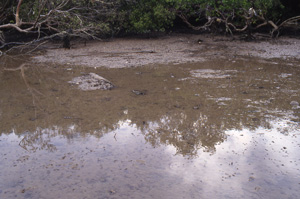
|
|
|
Distribution:
from the east coast of India to the Philippines and northern Australia; type locality: Madura Island, Java, Indonesia (Murdy, 1989)
|
Remarks:
Bleeker (1849) discriminated Apocryptes madurensis from
A. glyphisodon on the basis of the number of teeth. In fact, as also pointed out by both Koumans (1953)
and Murdy (1989), teeth numbers are quite variable in oxudercines (teeth are also often lost in preserved
specimens), with standard deviations usually larger within than amongst species (pers. obs.). The types of these two species are in poor conditions and do not allow for a proper
morphological comparison (Murdy, 1989). According to Murdy
(1989), the type material of Apocryptodon lomboyi Ablan,
An. montalbani Herre, An. sealei Herre and An. taylori Herre was lost during World War II, therefore he synonymised
these species on the basis of illustrations of the original descriptions (e.g. see below, drawings); nonetheless, Koumans
(1953) synonymised An. montalbani Herre, An. sealei
Herre and An. taylori Herre after having examined the type material in the Bureau of Science of Manila, Philippines. The type material
of An. malcolmi (USNM 90323) was examined by both these authors, therefore only the type material of An. lomboyi Ablan was apparently never re-examined.
It should also be noted that Koumans (1953) synonymised An. madurensis (Bleeker)
also with A. punctatus Tomiyama, here considered here as a valid species
(sensu Murdy, 1989).
According to Doug Hoese and Helen K. Larson, two different species
of Apocryptodon are found in northern Australia: with and without dark spots on the body, respectively
(Murdy, 1989; H. Larson, pers. comm.).
|
Photographs of Apocryptodon madurensis:
|
A: live specimen in aquarium collected in Sarimbun, Singapore (photo: T.H. Hui, in
Larson & Lim, 2005)*; B: a freshly dead specimen from Phuket, Thailand (photo: R. Winterbottom, in Larson & Lim, 2005)* - * with permission
|
Drawings of Apocryptodon madurensis:
A: cephalic sensory and nasal pores of Apocryptodon spp.:
an = anterior nostril; ao = anterior oculoscapular canal pore;
pn = posterior nostril; sp = supraorbital pore (modified from Murdy, 1989)*;
B: dorsolateral view of the parapophyseal extension of the 4th vertebra (An. madurensis: Murdy, 1989, modified)*;
C: Apocryptodon montalbani Herre from Iloilo, Philippines (above) and A. taylori
Herre from Tablas, Philippines (below) (Herre, 1927);
D: Apocryptodon madurensis (Bleeker)
(Kuang & Ni, 1986);
E: Apocryptodon madurensis (Bleeker)
(Koumans, 1953);
F: Apocryptes bleekeri Day (Day, 1876)
; G: Apocryptodon glyphydodon Blk. (= Apocryptes glyphisodon
Bleeker; Bleeker, 1983)*; H: Apocryptodon malcolmi Smith (Smith, 1931) - * with permission
|




